
© Railway Wonders of the World 2012-


American Pioneer Locomotives
Famous engines which were the forerunners of the giant locomotives of today
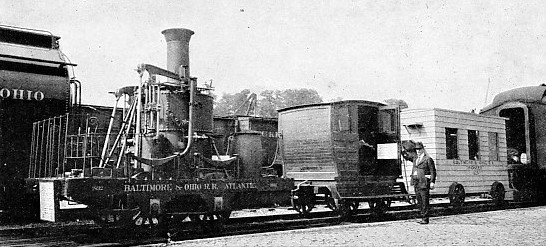
THE “ATLANTIC”, THE PIONEER OF THE BALTIMORE AND OHIO RAILROAD, 1832. It weighs 6½ tons, and of this amount about 4 tons are imposed upon the driving axle. The cylinders are 10 by 20 inches, working at 50-
THE attention of the United States of America was first drawn to the locomotive by the performance of “No. 1” on the Stockton and Darlington Railway, and the first railway in the United States was taken in hand in 1826. It was of modest proportions, and was called the “Granite Railway” for the reason that the 3½ miles of line were laid to permit the cheaper haulage of the granite used in the construction of the Bunker Hill Monument. It was never operated by a locomotive, but, at a later date, when railway expansion became general throughout the New England states, was absorbed by the Old Colony Railroad, which, in turn, underwent absorption by the present New York, New Haven and Hartford Railroad. The site of the original line is indicated by a stone monument about six miles out of Boston.
The introduction of the locomotive to the New World was due to the enterprise of Mr. John B. Jervis, chief engineer to the Delaware and Hudson Canal Company, who persuaded the canal company to commence the construction of a short line between Carbondale and Honesdale in Pennsylvania.
The chief engineer had discovered a young graduate from Columbia College, Horatio Allen, who was appointed resident engineer upon one section of the canal construction works. Allen had been following, on the spot, the working of the Stockton and Darlington Railway, and on his return to America he immediately communicated the results of his observations to Jervis, who was so impressed that he persuaded the directors of the canal company to send Allen back to England to inspect the iron used in the construction of the road, and to invest him with powers to purchase three locomotives, built to his approved design, for use upon-
The instructions laid down by Jervis were explicit. The weight of the engine was not to exceed 7 tons; if it could be kept to 6½ tons he would be much more satisfied. At that time all locomotives were built with four wheels, but the American engineer was anxious to obtain a six-
The builders, however, did not feel justified, from their limited experience, in attempting to satisfy all the American specifications. They produced a four-
The historic locomotive was blocked up in the yard to allow its wheels to revolve freely with steam supplied from the boiler serving the plant of the shops, for it was not possible to put the engine through its paces in the yard owing to absence of a track. About July 1 it was sent up the North River by barge to Rondout, where it entered the canal of its owners to proceed to Honesdale, which it reached on July 4, to be transferred to the railway running thence to Carbondale.
The “Stourbridge Lion”, as it stood upon the rails, was regarded with awe. Wiseacres said the track would never stand it, and misgivings were seemingly justified. The track consisted of flat bars of iron, about 1¼ inch wide by ½ inch thick, spiked to longitudinal sleepers of hemlock, measuring 12 inches thick by 6 inches wide, really forming the longitudinal members, or stringers, to the timber trestling and resting on timber caps spaced 10 feet apart. The line was built in the summer-
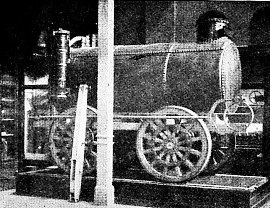
THE “STOURBRIDGE LION”. This, the first locomotive, built in Britain, to run in the United States proved a dismal failure. The abandoned engine was despoiled, but ultimately the historic remnants were collected to be preserved in the National Museum at Washington.
The trial trip was to be made from the town to a point in the woods about 3 miles distant. It was impossible to go farther owing to a low bridge which spanned the line and which would have knocked the chimney off the locomotive. The first section, about 500 feet, was straight: then
came the curve over the creek. This was between 350 and 400 feet in radius, and supported on trestling was about 30 feet in height.
The engine was coaled with local fuel and steam was raised. The only man familiar with the monster was Horatio Allen, and he volunteered to show what “The Lion” could do.
The “Stourbridge Lion”, estimated to be of 9 horse-
In this manner Horatio Allen made the first railway trip by locomotive in the Western Hemisphere, and always declared the incident to be the proudest in his life.
Although Allen demonstrated the possibilities of the “Stourbridge Lion”, it was reluctantly decided by the directors to be unsuitable for the designed purpose. The road was too weak to support it. Rather than entail the expense of rebuilding the trestling the original proposal was abandoned. “The Lion” was run off the track to be left beside the metals uncared for.
Weeds and grasses strove to conceal it; souvenir hunters appropriated such parts as they could carry away conveniently; while local metal workers considered it to be a fruitful fount for such odds and ends of material as they required. Within a comparatively short time it completely lost all value as, and nearly every semblance to, a locomotive, although its sturdy boiler was reclaimed for use ultimately to supply steam to a stationary engine in Carbondale. The wheels, axles and other cumbrous parts were thrown to one side to be sold ultimately for old iron.
Some years later the sentimental and historical interest attached to the first locomotive to run upon the American continent made itself manifest. Vigilant search for such parts of the “Stourbridge Lion” as remained was made for preservation in the Smithsonian Institution at Washington. The only original parts existing are the boiler, one cylinder, the wheel tyres, and one walking-
In the South Kensington Museum stands the “Agenoria”, built at Stourbridge the same year, and practically identical with those constructed for America. The British locomotive shared a more fortunate fate than her sisters dispatched across the Atlantic. She was built for the Shutt End Railway at Kingswinford, opened in June, 1829, two months before the “Stourbridge Lion” made its only railway journey. The “Agenoria” proved successful in operation, and remained in service for over 30 years. This record renders the assumed failure of “The Lion” in the United States
additionally remarkable, and conclusively proves that it was the railway, and not the locomotive, that was at fault.
Although the initial attempt to introduce the locomotive to the United States proved such a dismal failure, progress could not be arrested. David Matthew, a foreman mechanic, a little later was engaged in fitting up “The Best Friend of Charleston”, under construction for the South Carolina Railroad, 13 miles in length, the first American railway to receive a charter for the conveyance of passengers.
This locomotive, shipped to the south in October, 1830, proved a conspicuous success until June 17, 1831. On that day, through the negligence of the fireman, who, if he did not actually sit, at all events leaned, upon the safety-
Shortly afterwards the Raleigh and Gaston Railroad, the parent of the Seaboard Air Line, imported from England the “Tornado”, built by Edward Bury and Company of Liverpool. This firm, established at the Clarence Foundry as general engineers, embarked upon the construction of locomotives in 1829. It speedily gained a world-
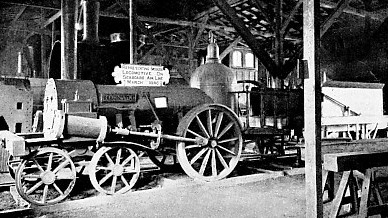
FULL-
Many conspicuous features were embodied in the Bury engines, notably the cylindrical fire-
Some years ago Albert Johnson, the first driver of the “Tornado” — the second engine built for the line — contrived a full-
In 1831 a powerful effort was made to encourage the foundation of a home industry by the Baltimore and Ohio Railroad. It followed the example of the Liverpool and Manchester Railway, by offering a prize of £800 for the most approved engine of American manufacture delivered for trial upon the road on or before June 1, 1831. This railway, one of the oldest and most famous in the United States — the “Railway University”, as it is frequently called — received its charter on February 28, 1827, for the construction of a line, 379 miles in length, from Baltimore to Wheeling, with its toil over the Alleghany Mountains. The outstanding feature of the line is the grade of 116 feet per mile to overcome the range. The road was built for adhesion working, but, when it was completed, at a cost of several millions, the company was in a delightful state of uncertainty as to whether it had a locomotive capable of climbing the long bank with a train.
When the first section to Ellicott’s Mills, 13 miles, was opened, in May, 1830, the coaches were drawn by horses and mules over the single track at the maximum speed of 10 miles per hour. As an improvement upon animal haulage an ingenious mind contrived a car with a sail, the “Aeolus”. Obviously, the wind-
It was stipulated that the engine should not exceed 3½ tons in weight, should burn coal or coke, and consume its own smoke. It was to be able to draw, on the level “day by day”, a useful load of 15 tons. The steam pressure was not to exceed 100 lb. per square inch — it was intimated that a lower pressure would find greater favour, all other things being equal, in the eyes of the judges. Only the engine was required; the railway undertook to “furnish a tender and supply of water and fuel.”
Three locomotives were forthcoming, but only one of these, the “York”, with vertical boiler and cylinder, was found capable of doing any useful work, though its performance, beyond demonstrating the possibility of travelling over curves of 400 feet radius in safety at 15 miles an hour, fell short of the conditions of the competition. After undergoing appreciable modifications it succeeded in drawing 15 tons at 15 miles an hour on the level, the slow piston speed being increased to give velocity to the driving wheels, of small diameter, by the introduction of gearing. This experimental locomotive was only retained for a short while, being superseded by the “Atlantic”, which may be said to represent the first practical locomotive produced by an American builder and the pioneer of the Baltimore and Ohio system.
In the “Atlantic” the vertical boiler and cylinder practice is perpetuated. It weighs 6½ tons, and of this amount about 4 tons are borne by the driving axle. The spur driving wheel is 28 inches, and its pinion on the driving axle 14 inches in diameter. The boiler is 69 inches in height above the grate by 51 inches in diameter; fire-
There are 282 tubes, 16 inches long, tapering from 1½ inches diameter at the bottom end to 1 inch at the top. The smoke-
during the first month over the 40 miles of line then open for traffic, making one round trip of 80 miles daily, and burning anthracite fuel. Up to the end of 1833 the engine had covered 13,280 miles with a consumption of 190 tons of coal, costing 32s. 6d. per ton.
So satisfied were the engineers of the railway with the upright tubular boiler as to retain this design for the six successive locomotives, built by Davis and Gartner, the firm that produced the “Atlantic”.
Despite this satisfaction the Baltimore and Ohio Railroad had to realize that it must come into line with the more advanced practice then ruling. So in 1837 means of laying the boiler on its side were devised — a somewhat belated acknowledgment of the superiority of British design. Although these engines had much in common with their predecessors in regard to mechanical details, it was considered necessary to introduce a colloquial distinction. So the new type with horizontal boilers were designated “crabs”, from the motion of the beams now recalling the movement of this crustacean.
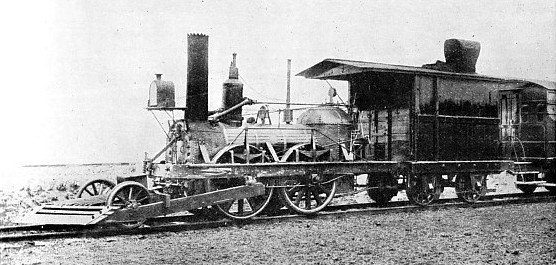
“JOHN BULL”, A BRITISH-
WHILE the Baltimore and Ohio Railroad was experimenting with the locomotive problem another line farther north was making history. This was the Camden and Amboy Railroad, for which Robert Stephenson, who had reorganized and was now in individual control of the Forth Street Works of Newcastle-
“John Bull” remained in regular service until 1865, and, while retired, is preserved in running order; its present permanent home is alongside the fragments of the “Stourbridge Lion” in the National Museum at Washington.
From time to time, during its thirty-
No tender was shipped from England, but for the trial trip the driver requisitioned an old flat car on which he placed a whisky cask to serve as the tank, a section of hose made by a local cobbler being used to lead the water to the feed pumps. After being-
In 1832 the American engineers completed their first radical alteration. This was the fitting of a two-
After standing idle for twenty-
It was the New England states which attractive market in America for British locomotive builders. The newly-
The transformation wrought upon the local coal industry by the Stockton and Darlington Railway was not lost upon American colliery interests. Certain far-
By this time the domestic manufacturing situation had undergone a change. Enterprising commercial adventurers, determined to be in the van of progress, had established works, and were beginning to compete successfully with the older British firms. Among these competitors was a jeweller of Philadelphia, Matthias M. Baldwin, who, finding a diminishing market for trinkets, turned to the new utilitarian product. He built a locomotive according to his own ideas, based upon such particulars of the competing engines at Rainhill as he could obtain, which proved highly promising when submitted to test.
He was thereupon given an order for the construction of a locomotive, at the mutually agreed price of ££800, for the Philadelphia, Germantown and Norristown Railroad, 6 miles in length. At that time “John Bull”, shipped from England, was lying at Bordentown, awaiting assembly, and Baldwin was urged to examine it. He did so, and returning home he evolved a design, broadly based upon Stephenson’s ideas, which resulted in the American locomotive “Old Ironsides”. It was delivered to the railway, but the company, declaring it did not comply with specifications, demurred against the price, and eventually Baldwin reluctantly accepted £750 in full settlement.
The unlucky termination to his first venture into the new field caused Baldwin to declare that he would never make another locomotive, but he was forced to reconsider this decision through the importuning of E. L. Miller, who had contracted to supply the Charleston and Hamburg Railroad with a locomotive, and who approached the Philadelphia engineer to carry out its construction. He urged Baldwin to visit the Mohawk and Hudson Railway, upon which had recently been placed one of Stephenson’s celebrated “Planet” type, with horizontal cylinders and crank axle, but the front wheels of which had been removed to permit the installation of a four-
By the time the Philadelphia and Read ing Railroad was ready for its motive power Baldwin was firmly established, and the order for the first locomotive was placed with him. At the same time, however, a contract was placed with Braithwaite and Company, of London, for eight locomotives, which were duly delivered during 1837 and 1838. The first of this series was named “Rocket”, after Stephenson’s famous pioneer. Upon arrival at Philadelphia these engines were transferred to barges for conveyance through the Schuykill Canal to the foot of Penn Street, Reading; thence they were hauled over the high road, on their own wheels, by horses to the railway terminus at Seventh and Penn Streets, and set upon the metals.
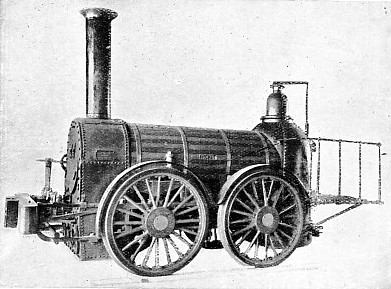
BRITISH-
The “Rocket” went into regular passenger traffic during May, 1838, to remain continuously at work for 41 years, being withdrawn in March, 1879, after covering 310,164 miles. The Philadelphia and Reading pioneer rivals in fame the historic “John Bull”, but the hand of the modernizer has rested more lightly upon the “Rocket”; she was altered very slightly by her American engineers. The most important change was that made after some seven years’ service.
The locomotive engineers took the engine in hand to adapt her to hard coal if possible, and, by completing a certain degree of remodelling and reconstruction of the fire-
The “Rocket” weighs 8.4 tons, and, with the train of coaches of the type of her day, was able to make 25 to 30 miles an hour.
Upon the termination of her forty-
By the end of the opening decade of the Victorian era the American railways had ceased to depend upon British locomotive manufacturers for their requirements. This was due, in a very pronounced degree, to the British designers not being disposed to adapt their designs to local conditions, although, of course, the home demand was taxing their producing resources to the utmost. Nevertheless, had the British builders studied American conditions a little more sympathetically, and profited by the advice which was freely offered, American builders would not have triumphed so easily.
When John Jervis, who fathered the introduction of the locomotive to the United States with the ill-
When the new handmaid to civilization commenced to penetrate the Middle West the native builders received distinct encouragement; they visualized the future and planned accordingly. This great movement, which proved to be the greatest in American railway history, was pivoted on Chicago, which for many years was virtually cut off from the seaboard except by river, canal and wagon road.
It was in 1838 that the first step was taken with the incorporation, on January 16, of the Galena and Chicago Union Railroad, charged with the construction of a line from the then settlement of shacks on the shore of Lake Michigan and Galena to the west. One clause in the charter makes interesting reading to-
The railway-
As many miles of such land had to be traversed, the fathers of the scheme wondered if they had not made a mistake by venturing westward. For ten years the scheme remained in abeyance, although certain communities, who were bound to profit from the provision of communication, fretted and chafed under the inactivity.
The tide turned in 1846 when the original Galena and Chicago Union Railroad project was revived at a convention held at Rockford, and attended by delegates from all the counties to be traversed or served by the line. A resolution to subscribe publicly to the stock was carried, the communities likely to benefit from the railway contributing as liberally as their limited means would permit.
Sufficient money at last being forthcoming, the charter of the defunct company was acquired, and the contract for the first 32 miles of line was let on March 31, 1848. According to the terms 16 miles of the road were to be finished by August 1, and the second section by October 1 following. Thus 32 miles of line were to be built in six months. The first surveyor’s peg was driven into the ground near the corner of Kinzie and Halstead Streets, then outside the Chicago boundary, this starting point being selected for the simple reason that the authorities refused to permit the railway to enter the limits of the city. Nevertheless, the Council graciously granted the railway permission to build a temporary road eastwards as far as the river, to allow one of the two locomotives to be landed and run on to the system.
It is scarcely necessary to relate that the terms of the contract were not carried out. By November 20 the line had crept to a point only 10 miles west of Chicago, but it was opened to the frantic cheering of the populace gathered from miles around. The first train was fully in keeping with the name of the locomotive which hauled it — “Pioneer”. Two locomotives were purchased to handle the traffic, but the one mentioned was the first to reach Chicago — hence the name. Evidently the funds of the company were somewhat low because the latter was content with a second-
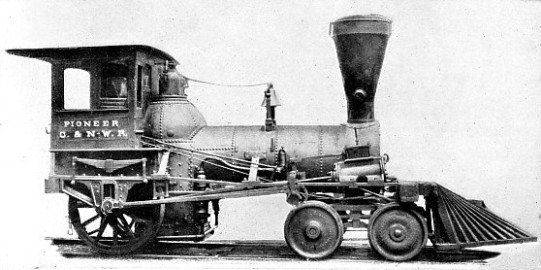
“PIONEER,” THE FIRST LOCOMOTIVE IN CHICAGO, 1848. Complete with bell and cab—the last-
“Pioneer” was dispatched to Chicago by water, and landed from the brig Buffalo on October 18, 1848. The engine was of the 4-
At the opening ceremony the railway owned this one locomotive, a single passenger coach and six freight vehicles. But the little line flourished amazingly; its traffic grew so rapidly that, within two years of being opened, the output of the shops which the company had established for building rolling-
Construction was pushed forward. The main objective was Council Bluffs on the Missouri River, the stimulating influence being the first American transcontinental, which was then being advanced from Omaha to San Francisco. The Galena and Chicago Union Railroad sought to effect a junction with the Union Pacific with all speed. Before this section of the task could be completed, however, the pioneer railway out of Chicago lost its identity; it was swallowed up by the Chicago and North Western Railroad.
Late in the afternoon of September g, 1861, the city of St. Paul, then merely a trading outpost on the Mississippi River, was agog with excitement. Trailing behind the steamboat was a dumb barge on which was secured the first locomotive to be seen in the American north-
The “Wm. Crooks”, officially known as “No. 1, 1st Division, St. Paul and Pacific Railroad”, was built by Smith and Jackson, at Paterson, New Jersey, which by that time had become an important locomotive building centre. It is of the American 4-
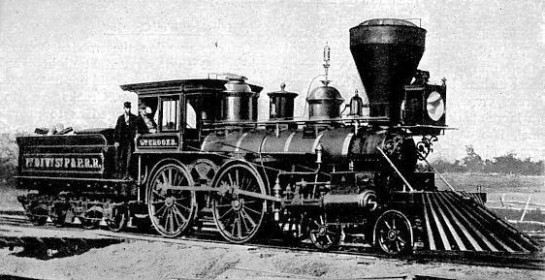
THE AMERICAN-
As “Wm. Crooks” burned cord-
During its career “Wm. Crooks” has burned peat, wood, and coal -
The locomotive reached its destination somewhat earlier than had been expected, and as there was no accommodation for her, and the cars she was to haul had not arrived, a rough shed was fashioned to shelter her for the winter. With the coming of spring her assembly was hurried forward, she was groomed, fired, and steam raised. She was then run light over the completed road to test her qualities and to break her in to running. The railway cars reached the city on June 28, 1862, were run on to the metals, and that afternoon the first train to snort through the woods of Minnesota pulled out of St. Paul, packed to the utmost capacity with excited living freight.
Four days later the regular passenger service between St. Paul and St. Anthony, a distance of 10 miles, was opened to heavy business, the locomotive being kept continuously running to and fro, moving excursionists anxious to taste the novelty of travel by train. The tender of the “Wm. Crooks” carried only two cords of wood, and in winter this supply would often be exhausted before the next pile standing beside the track could be reached. Then the driver and fireman tore up the fences alongside to keep steam going, the protection being replaced the following summer.
On one occasion the wooden house in which the engine rested at night caught fire. The locomotive could not be rescued. When recovered “Wm. Crooks” was in a sorry plight; so damaged as to provoke thoughts of immediate consignment to the scrap-
During these years the line grew steadily, and the locomotive became subjected to heavier and more exacting duty. It was designed to haul 60 tons on the level, while its speed was 15 to 20 miles an hour. Under favourable conditions a good turn of speed was shown, the fastest run being one of 15 miles in 16 minutes.
In 1879 Minnesota’s pioneer line passed into other hands, to become known as the St. Paul, Minneapolis and Manitoba Railway, until 1885, when it was renamed the Great Northern Railway Company, which survives.
These changes caused “Wm. Crooks” to be transferred to lighter, easier, and more varied duty. But one day, during 1900, the locomotive came ambling into the yard for the last time, was pushed to the end of a siding along with several broken-
But “Wm. Crooks” was spared this ignominious fate. In 1908 it was decided to invite Mr. James J. Hill, the chairman of the railway company, to a dinner at Lake Minnetonka upon the occasion of his 70th birthday. The “Grand Old Man”, when approached, entered into the spirit of the reunion, and, to preserve the atmosphere of the past, asked if the first locomotive to run on the railway happened to be in existence to haul the train of pioneers. It was — but 2,000 miles away!
The officials of the yard in which “Wm. Crooks” was standing, neglected, if not forgotten, exposed to the ravages of wind and weather, were instructed by telegraph to drag her out and to attach her to the next eastward-
James J. Hill, his interest now aroused, expressed his intention to send the veteran to the Alaska-
You can read more on “America’s First Trains”, “The Story of the Locomotive” and “When Railways Were New” on this website.